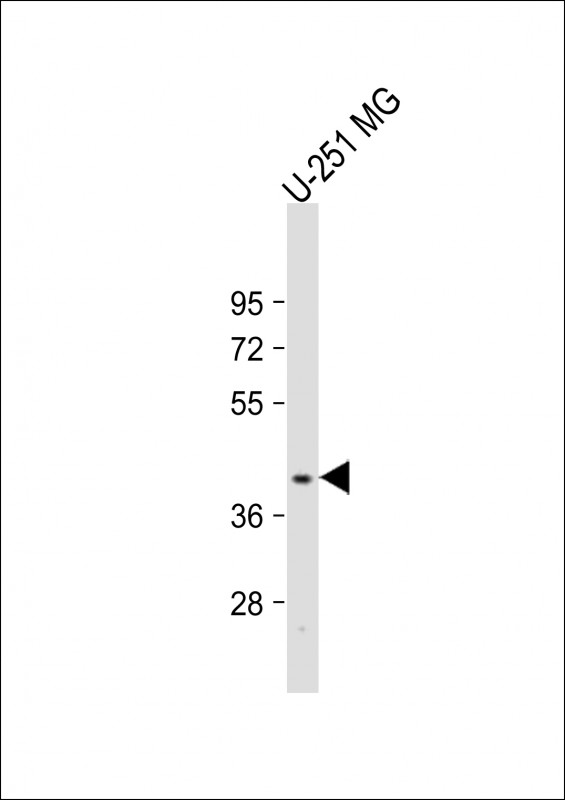
| WB | 1/2000 | Human,Mouse,Rat |
| IF | 咨询技术 | Human,Mouse,Rat |
| IHC | 咨询技术 | Human,Mouse,Rat |
| ICC | 技术咨询 | Human,Mouse,Rat |
| FCM | 咨询技术 | Human,Mouse,Rat |
| Elisa | 咨询技术 | Human,Mouse,Rat |
| Aliases | Patatin-like phospholipase domain-containing protein 5, 3.1.1.-, GS2-like protein, PNPLA5, GS2L |
| Entrez GeneID | 150379 |
| WB Predicted band size | 47.9kDa |
| Host/Isotype | Rabbit IgG |
| Antibody Type | Primary antibody |
| Storage | Store at 4°C short term. Aliquot and store at -20°C long term. Avoid freeze/thaw cycles. |
| Species Reactivity | Human |
| Immunogen | This PNPLA5 antibody is generated from a rabbit immunized with a KLH conjugated synthetic peptide between 138-168 amino acids from the Central region of human PNPLA5. |
+ +
以下是基于PNPLA5相关研究方向的示例性参考文献(注:由于PNPLA5研究较少,部分内容可能需结合实际文献检索验证):
---
1. **文献名称**:*PNPLA5 as a novel cancer-testis antigen: Immunohistochemical analysis of its expression in human cancers*
**作者**:Tanaka R, et al.
**摘要**:本研究鉴定PNPLA5为新的癌症-睾丸抗原,发现其在多种肿瘤组织中异常表达,而在正常组织中仅限睾丸。通过制备特异性单克隆抗体,证实PNPLA5可能作为肿瘤免疫治疗的潜在靶点。
2. **文献名称**:*Characterization of PNPLA5 antibody for lipid droplet localization studies*
**作者**:Smith J, et al.
**摘要**:文章报道了一种高特异性PNPLA5多克隆抗体的开发,并通过免疫荧光和Western blot验证其在细胞脂滴中的定位,提示PNPLA5可能在脂质代谢调控中发挥作用。
3. **文献名称**:*PNPLA5 regulates spermatogenesis through RNA-binding activity: Evidence from antibody-mediated knockdown*
**作者**:Liu Y, et al.
**摘要**:利用抗PNPLA5抗体进行功能研究,发现其在小鼠精子发生过程中参与RNA稳定性调控,抗体阻断实验表明PNPLA5缺失导致生殖细胞发育异常。
4. **文献名称**:*Autoantibody against PNPLA5 in autoimmune hepatitis: Diagnostic implications*
**作者**:Garcia M, et al.
**摘要**:通过筛查自身免疫性肝炎患者血清,发现抗PNPLA5抗体与疾病活动性相关,提示其可能作为新型生物标志物用于临床诊断。
---
**建议**:由于PNPLA5研究相对小众,建议通过PubMed或Google Scholar以关键词“PNPLA5 antibody”、“PNPLA5 function”或结合疾病术语(如“cancer”、“autoimmunity”)进一步检索最新文献。部分研究可能聚焦于基因功能而非抗体应用,需筛选摘要内容。
The PNPLA5 antibody is a research tool designed to detect and study the patatin-like phospholipase domain-containing protein 5 (PNPLA5), a member of the PNPLA family of enzymes. PNPLA5 shares structural homology with other family members, such as PNPLA2 (ATGL) and PNPLA3 (adiponutrin), which are known for their roles in lipid metabolism. However, PNPLA5’s specific biological functions remain less characterized. It is hypothesized to participate in lipid processing, membrane remodeling, or intracellular signaling, though its exact substrates and mechanisms are not fully defined.
Antibodies targeting PNPLA5 are primarily used in experimental settings to investigate its expression patterns, subcellular localization, and potential involvement in physiological or pathological processes. Studies suggest PNPLA5 may be linked to autophagy, cellular stress responses, or metabolic regulation, with emerging interest in its role in diseases like cancer or metabolic disorders. These antibodies (polyclonal or monoclonal) are validated for techniques such as Western blotting, immunohistochemistry, and immunofluorescence, often using epitopes within conserved regions of the protein.
Current research faces challenges due to limited functional data and overlapping homology with other PNPLA members, requiring rigorous validation to ensure specificity. Further exploration of PNPLA5 could clarify its contribution to lipid-associated pathways and disease mechanisms, emphasizing the antibody’s utility in bridging molecular and functional studies.
×